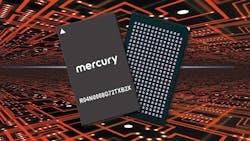Dense DDR4 Memory Uses Space Wisely
Memory is a key electronic component for consideration when designing systems and subsystems for reduced size, weight, and power (SWaP). Of course, not all operating environments are equal and computer memory developed for deep-space applications must be extremely tolerant of high radiation levels.
To help the cause, Mercury Systems developed an 8-GB, radiation-tolerant DDR4 memory module (see image above). It combines advanced design and packaging techniques to miniaturize SDRAM memory into a compact, high-density, space-qualified module.
The miniature memory module is based on advanced 3D packaging techniques. By targeting high-speed performance at lower-power levels, the space-qualified module can achieve as much as 87% space savings even in radiation-challenged operating environments. In addition to developing a densely packed DDR memory layout, the DDR4 memory module makes use of compact plastic ball-grid-array (BGA) packaging and multiple stacked memory die to fit as much memory capacity as possible in the smallest housings possible.
The memory modules are produced in a defense microelectronics activity (DMEA), AS9100-certified manufacturing facility, built to deliver consistent and reliable performance across wide military operating temperatures. Available with capacities from 128 MB to 16 GB, the miniature memory modules achieve transfer speeds to 2400 Mb/s and support 72-bit-wide data buses to exercise reliable error-detection-and-correction (EDAC) techniques.
About the Author
Jack Browne
Technical Contributor
Jack Browne, Technical Contributor, has worked in technical publishing for over 30 years. He managed the content and production of three technical journals while at the American Institute of Physics, including Medical Physics and the Journal of Vacuum Science & Technology. He has been a Publisher and Editor for Penton Media, started the firm’s Wireless Symposium & Exhibition trade show in 1993, and currently serves as Technical Contributor for that company's Microwaves & RF magazine. Browne, who holds a BS in Mathematics from City College of New York and BA degrees in English and Philosophy from Fordham University, is a member of the IEEE.
